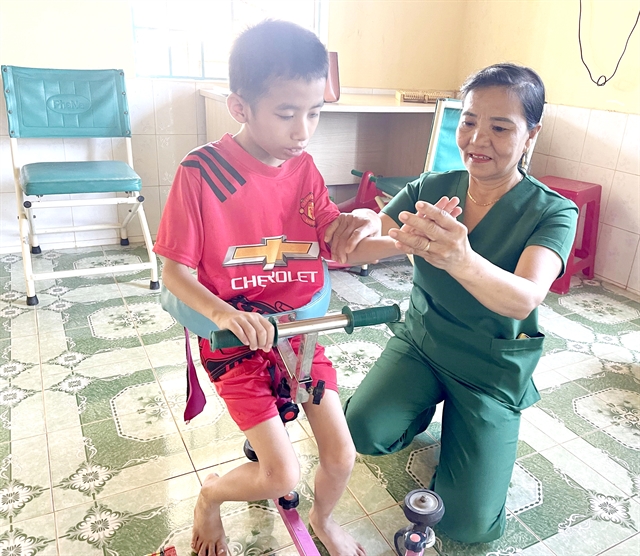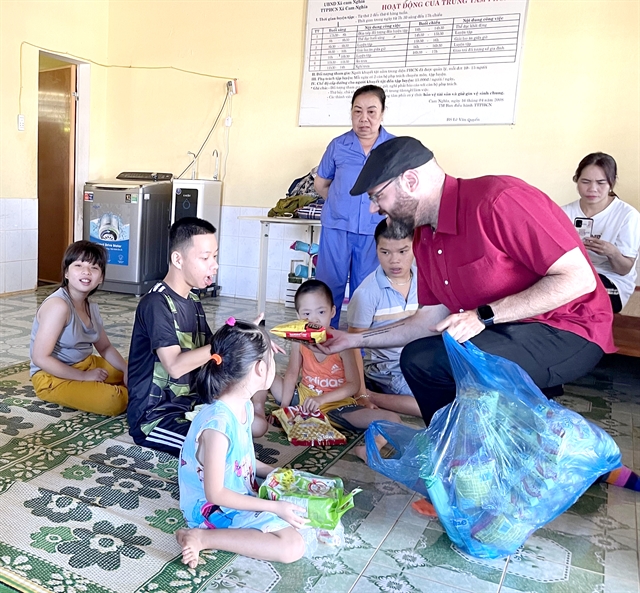 Society
Society

The rehabilitation centre of Cam Nghĩa Commune in Quảng Trị District has been considered to be a second home for hundreds of severely disabled children and their parents for many years.

|
| A teacher instructs a disabled boy to do a rehabilitation exercise. — VNA/VNS Photo Thanh Thuỷ |
Thanh Thuỷ
QUẢNG TRỊ — The rehabilitation centre of Cam Nghĩa Commune in Quảng Trị District has been considered to be a second home for hundreds of severely disabled children and their parents for many years.
The centre cares for and treats children with disabilities likely caused by the dioxin known as Agent Orange, which was used as a defoliant during the war.
For the past nine years, Nguyễn Thị Thuận, 43, has brought her three-year-old son to the centre every morning.
Thuận is very reassured when her child is cared for and rehabilitated at the centre as her son is taken care of by four teachers.
Twelve years ago, when she gave birth to her son, there was no greater pain than knowing that he got cerebral palsy due to Agent Orange.
Unlike other children his age, he is very thin and weak, and whenever the weather changes he is constantly ill.
Over the years, the rehabilitation centre has become not only a destination for rehabilitation but also a second "home" for Thuận and her son and many other parents and children with disabilities in the commune.
It is because here those children are cared for, taught, and rehabilitated while parents have learnt more knowledge about properly caring for and raising their children in accordance with their children’s psychophysiological health.
“Over the past 12 years, I and my husband have not had a good night's sleep because my son was not born like other children,” Thuận said with tears.
“The whole family loves him so much. All the money we spent to treat his illness did not help,” Thuận said.
Treated at the rehabilitation centre in Cam Nghĩa Commune, the boy’s physical and psychological health has improved dramatically.
In the centre, the disabled children are cared for by their teachers and get their appropriate rehabilitation exercises.
Like Thuận, Lê Thị Trang, 45, has a nine-year-old daughter who is undergoing rehabilitation at the centre.
Trang said that her daughter was affected by Agent Orange, so she had congenital heart disease and was very weak.
“For years, the centre has always been my daughter’s favourite destination,” Trang said.
“Here, the children practice rehabilitation exercises, are taught communication skills and play with each other and teachers, which make them very happy and excited,” Trang said.
“The centre not only teaches the children but provides parents with valuable knowledge in health care as well as how to handle emergencies when the children get health problems,” she said.
Established in April 2008, Cam Nghĩa Rehabilitation Centre operates under the management of Cam Nghĩa Commune’s People's Committee.
The centre takes care of 30 disabled children affected by Agent Orange in the two communes of Cam Chính and Cam Nghĩa of Cam Lộ District.
The centre has four teachers caring for and instructing rehabilitation exercises for the children.
Funding for the operation is mainly from the support of benefactors, agencies, organisations and Renew Project - a co-operation programme between Quảng Trị Province and international non-governmental organisations in an effort to reduce the number of deaths and injuries from cluster bombs and other unexploded ordnance left over from the war.
Working at the centre from the first days until now, Nguyễn Thị Thương, the centre manager, said that at the time of its establishment, the centre faced many difficulties and lacked both facilities and money.
Over the years, the centre’s operations have been funded by benefactors, organisations, agencies and co-operation projects, Thương said.
“Unlike normal children, the teaching, care and rehabilitation of children with disabilities caused by Agent Orange is more difficult, requiring more love, perseverance and persistence from the teachers,” said Thương.
“Based on the health status and disability of each child, the centre has appropriate exercises and lessons,” said Thương.
Since its operation, the centre has always received the trust of parents and the love of children.
In recent years, among the disabled children who have been rehabilitated here, many children have integrated into the community, got married, and had jobs.
In particular, one of them has become a teacher for children with disabilities.
That is the joy and pride of the centre, said the manager.

|
| Children with disabilities receive gifts from a donor. — VNA/VNS Photo Thanh Thuỷ |
Cam Nghĩa is a locality that was heavily affected during the war with a large number of people affected by Agent Orange and landmine accidents.
The whole commune has 356 people with disabilities from 170 households, many of which have two or three children with disabilities due to Agent Orange.
Cam Nghĩa Rehabilitation Centre has provided free of charge care for children with disabilities including Agent Orange victims, children with motor disabilities, cerebral palsy and visual impairments.
“Currently, the centre is facing difficulties in funding, equipment and human resources. It is in dire need of support from authorities at all levels as well as organisations and benefactors,” said Thương.
Nguyễn Anh Hai, vice chairman of the Cam Nghĩa People's Committee, said that most of the families of children with disabilities at the centre are poor so the centre has partly supported the cost of caring, nurturing and educating children for the families.
However, Project Renew's support programme is currently in its final stage and will end on September 30, 2023 so the centre is in danger of being dissolved if it does not receive support in the near future, said Hai.
“I wish that the centre would continue to receive financial support as well as rehabilitation facilities and equipment to maintain operations, thereby contributing to support poor children with disabilities in the area,” he said. — VNS




